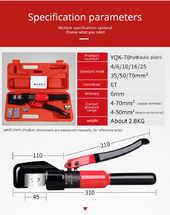timselectric
If I can do it, you can do it.
- Joined
- Feb 5, 2022
- Messages
- 18,619
Ah, I didn't see that one.One isn't.
Ah, I didn't see that one.One isn't.
This is a custom bus bar in that location - for turning the corner between row 1 and row 2, with the holes in the end of the bus bar.
Correct
Ive purchased 3 of those hydraulic crimpers. They all seem to be made by the same company. Harbor Freight, Amazon, etc.In earlier days a lot was mentioned about helpful tools for building your own batteries. Here is a partial display of items I have found very helpful in the process. I’m sure others have their own tools as well.
View attachment 181705
That’s what I’ve noticed. Just rebranded, sometimes the only difference is the gauge and amount of the dies.Ive purchased 3 of those hydraulic crimpers. They all seem to be made by the same company. Harbor Freight, Amazon, etc.


The standard Hydraulic Crimpers you get from China are in Metric / Millimeters and they work perfectly fine with Metric Wires, Lugs etc but trixy with AWG wires & lugs.
4.0mm = 12awg
6.0mm = 10awg
8.0mm = 9awg
10.0mm = 8awg
16.0mm = 6awg
25.0mm = 4awg
35.0mm = 2awg
50.0mm = 1awg
70.0mm = 2/0awg
The 70mm for 2/0 is NOT tight ! in fact you have to shave the dies a bit to make it really tight, 1mm off each side. OR you crimp with 70mm then again with 50mm to ensure a tight compressed fit BUT that leaves a pair of "wings" so keep that in mind. This also applied to the other AWG lust to varying degrees
The one I use is a Delixi 6-Ton. NOTE, The other type of crimper is BETTER than these closed models... Image showing better model also attached. There is also no need to go bigger than 8-Ton which will make perfectly airtight crimps with proper closed end lugs.
View attachment 191858
Better Model below
View attachment 191859
The one in the photo works well for smaller sized wires:
https://www.amazon.com/gp/product/B07QVBD6VM/ref=ppx_yo_dt_b_search_asin_title?ie=UTF8&th=1
Pappion, nice price, but the 9 pairs of dies seems right for me.This Hammer Lug Crimper worked well with a 3lb sledgehammer. Only $14.
I did want to confirm what @Steve_S said about the AWG conversion. Sometimes it is necessary to go to a smaller size. This can create "wings" which may need to be trimmed or knocked down, especially with the first unit I indicated.JJJJ, sweet! nice price and usa stock


